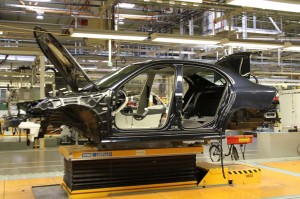Cash-starved Saab’s assembly lines have come to another grinding halt as the maker struggles to resolve a financial crisis that has shut down its headquarters plant for much of the last two months.
The news that the Trollhattan plant is down again, and likely won’t be running until at least next week – at the earliest – is a setback for the Swedish maker, which had hoped to resolve its problems with the partnership it inked last month with China’s largest dealer network.
But “the liquidity situation is still tense,” the Swedes acknowledged today, despite an initial payment from Pang Da. A number of other issues apparently have yet to be resolved, a Saab release noted, meaning production can be “easily disturbed” in the near-term.
“It is therefore very difficult to make further predictions,” as to when the Trollhattan plant will resume operations – and for how long, acknowledged production director Gunnar Brunius. As a result, he said, “We have to take one day at a time. In order to avoid taking on more supplies than necessary, we have decided to reduce production plans this week. We are all working hard to get production running consistently again, and as soon as possible.”
Saab has been struggling for years, though the Swedish company had hoped the situation would improve after it was sold by General Motors to the Dutch-based Spyker Cars in early 2010. But Spyker – newly renamed Swedish Automobile N.V. – almost immediately ran into problems of its own.
Prior to the sale, GM decided to halt production at Trollhattan and it took the new owners seven weeks to get the plant running again. That, in turn, resulted in a shortage of the new 9-5 model, cascading into a financial shortfall for Saab that made it difficult to pay its bills.
On March 29th, a key supplier decided to boycott, a move quickly joined by dozens of other vendors. With little inventory to fall back on, Saab’s prime plant was left on idle – though production of the new 9-4X crossover continued – and is still continuing – at a GM factory in Mexico.
A panicked Saab quickly set out to find new sources of capital. But several of its initial proposals were either rejected or simply ignored by its primary lender, the European Investment Bank, the EIB, despite support from the Swedish government.
Saab thought it found a way out of the mess when it lined up a partnership with the ambitious Chinese automaker, the Hawtai Group, which agreed to purchase a 29.9% stake of the Swedish carmaker. But that deal was rejected by Chinese bureaucrats, who maintain heavy control of their auto industry.
Days after the deal collapsed, Saab Chairman Victor Muller announced an alternative deal with Pang Da, China’s largest dealer group – which had just completed a new $1 billion IPO. Pang Da plans to buy a 24% stake in Saab – and to purchase millions of dollars of the Swedish maker’s products for sale through its hundreds of retail outlets.
But while there are signs the new deal will eventually be approved by the Chinese government Saab has been waiting and running short of cash, despite an initial infusion from Pang Da for the first boatload of cars.
Saab only resumed production on May 27th. Initially, company officials thought the latest production halt would be a brief one, but they now plan to use the coming days to train workers.
“It is hard to make any sort of prediction right now,” lamented a spokeswoman when asked what might come next, acknowledging the liquidity situation “is tense.”
One way to resolve the near-term situation would be through a proposed sale and lease-back of Saab’s plant and other assets to Russian banker Vladimir Antonov, a one-time partner of Saab Chairman Muller. But that deal continues to wait for approval from the EIB.

